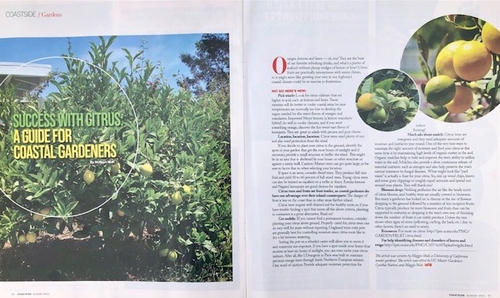- Author: Jamie M. Chan
- Editor: Cynthia Nations
With the holidays just around the corner, the gardener and horticulturist in your life would appreciate a thoughtful gift to fuel their passion for growing. We've rounded up a list of gift ideas including clever tools and supplies to use in the garden or ways to bring the outdoors inside during the upcoming winter months. Whether your recipient is the keeper of a palatial estate or the curator of an indoor jungle, these gifts will hopefully level up those plant parent skills for your loved one this season. Consider finding some of these garden gift ideas at your neighborhood nursery or hardware store to support the local small businesses this season.
Hori Hori Garden Knife
The hori hori garden knife is a popular Japanese garden knife. Hori hori roughly translates to “dig dig”. This beloved multi-purpose tool is built for versatility. From digging up weeds to measuring planting depth with the handy inch marks, it has many uses in the garden. The tool is rust-resistant and double edged, and it has the ability to dig, trench, or cut away at plants and root systems. You can replace several tools with this one knife. Approximate price range: $20-50
Garden Journal
Gardens are places of constant change. The way to a green thumb is to practice observation of the changes over time so you don't make the same mistake twice. Essential for gardeners of every skill level, a horticultural diary helps track both
successes and lessons learned. Approximate price range $10-30
Microgreens Growing Kit
Growing microgreens is one of the easiest, quickest, and most successful experiences for gardeners of all levels. They can be grown on the kitchen countertop without a lot of special materials or tools. Microgreens are essentially the sprouts of common edibles such as cabbage, radish, cilantro, sunflowers, kale, etc. You harvest the sprouts when
they're just a few inches tall. Scientists estimate you can get as much as 40 times the nutrients from microgreens, compared to mature plants! Approximate price range $20-40
Forcing Bulbs Indoors
Forcing bulbs such as paperwhite narcissus or amaryllis for holiday bloom couldn't be easier. Plant the bulbs in a container with a few inches of rocks or marbles. Add water to just below the bottom of the bulb. They will bloom in approximately four to six weeks. Paperwhites grow so fast, it makes a particularly fun science project to do with
kids. If you start them about four weeks before Christmas, a fully blooming pot of paperwhites can make a cost-effective and fragrant holiday gift for loved ones. Approximate cost: $5 or more depending on the container or rocks you choose.
Bonsai Tools
Have you ever bought a pair of pruning shears from the big box store only to have them bend or rust before the season is out? Bonsai tools are a gardener's secret weapon. Bonsai growers have been using the same pruning shears, hand-held digging tools and bud trimmers for thousands of years. Bonsai tools are made of high-carbon steel and have been designed and shaped by Chinese and Japanese bonsai masters for use in the art of shaping and dwarfing a bonsai tree. Consider purchasing Bonsai shears, pruners or saws as an unexpected garden gift that lasts a lifetime. Approximate cost $25-60+
We all have family and friends whose happy place is working with plants in the garden or indoors. The best holiday gifts are personal, tailored to the recipient's interest, and will bring joy for years to come. Both beginner and well-experienced horticulturists are sure to welcome new tools, bulbs or seeds, or other interesting botanical-focused gifts. Happy holidays!
This article was written by UC Master Gardener Jamie M. Chan who enjoys her beautiful garden in San Francisco. The article was edited by UC Master Gardener Cynthia Nations.

- Author: Maggie Mah
- Editor: Cynthia Nations
Whether it's a massive display or a tiny desktop bloom, there's nothing like an orchid for adding beauty and a sense of serenity to any decor. No surprise: these exotic divas of the plant world are more popular than ever, but caring for them can be intimidating. The good news is that you don't have to be a plant whisperer to have success with orchids. Just like human divas, they are temperamental, but if you give them what they need, they will perform for you. There are a
number of different commonly available orchids with both indoor and outdoor varieties to choose from. The information provided here applies generally to indoor orchids, particularly the widely popular Phalaenopsis.
Orchid's Origins:
Most commercially grown orchids are derived from plants originating in the tropics. Imagine for a moment that you are an orchid: you are growing in a sheltered spot probably up in a tree with your roots getting nutrients from crumbled bark that is moist but not soggy. Filtered sunlight streams in for most of the day. The air is comfortably warm and humid. The temperature is fairly constant for most of the year. Although we don't live in that idyllic setting, the orchid in your home needs similar conditions. Does this mean you have to create a tropical orchid spa? No, but it does mean paying attention to water, light and temperature.
Know Your Pot:
Orchids purchased at retail usually come in plastic pots which are often set into decorative containers. The advantage to plastic is that it retains moisture longer than porous materials like unglazed terra cotta. The downside is that it becomes easy to overwater your orchid. This is especially true if the pot is topped with decorative materials or set in an arrangement with other orchids. If you can't easily determine if there is adequate drainage, there will be trouble ahead. It's a hassle, but it's best to remove the orchid from the outer pot or arrangement to water it. (More on this to follow.) Failing that, test the moisture in the potting medium by carefully inserting a bamboo skewer all the way to the bottom of the pot. If it's evenly moist, don't add water and test again in a few days.
No ice, please!
We've all heard, “Just drop in an ice cube once a week.” Convenient? Yes. Good for the orchid? NO. Ice actually damages the tender tropical plant tissue where it is placed. This makes sense. (Except for rum drinks, there's not much ice in the tropics, right?) Similarly, orchids don't like cold water and won't absorb the moisture properly, and orchids usually need a lot more water than one ice cube provides.
The Right Way to Water:
Remove the orchid from the display pot and place it in a deep sink or dishpan. Using room temperature water from a pitcher or gentle spray nozzle (flexible shampoo attachments are great for this) drench your orchid from top to bottom. Be careful to avoid the flowers and wet the tops and undersides of the leaves as well as the pot. Set the orchid aside to drain thoroughly and wipe off any remaining drops of water on the leaves. Remember that your orchid's need for moisture changes according to ambient temperature and humidity. Although about once a week is a good rule of thumb, it might need to be watered much more often during the warmest part of the year. Watering in this way will also maintain moisture in the leaves and help prevent pest infestations.
Feeding Your Diva: How to Fertilize
Your orchid has a good appetite and needs to be fed about every two weeks with a good, preferably organic, fertilizer. You will need two kinds: one for growth, which contains nitrogen and one for blooming which does not contain nitrogen. The numbers on the label represent levels of nitrogen, phosphorus and potassium and will tell you which is which. Fertilizers with nitrogen will look something like this: 12-10-10. Fertilizers for blooming will look like this: 0-10-10; i.e., no nitrogen. While your orchid is flowering, feed with the latter kind. Once all the blooms are gone, look for new growth and switch to a fertilizer containing nitrogen.
Good Lighting is a Must:
Insufficient light is a key reason that orchids fail to re-bloom. Although different types of orchids have varying light requirements, a good rule of thumb is to provide at least 6 hours of light from a window every day. Start by observing the light in several places in your home at different times of the day. Then, to be sure the light is sufficient but not too strong, test by holding your hand between the plant and the window, about a foot away from the orchid. If your hand casts a faint shadow on the leaves you have enough light for most orchids such as Phalaenopsis. If it casts a sharp shadow, it may be too strong or better for other types such as Cattleyas. If the light is too strong, you can also add a sheer curtain to provide a filter.
Grooming your diva:
Remove wilting blooms right away to prolong the life of the remaining flowers. When blossoms start to droop and fade, they emit ethylene gas which hastens the demise of the other flowers. Once all the blossoms are gone, cut the spike (flower stem) back either partway down (between nodes) or at the base. Make sure whatever you use to cut, is sharp and sanitized first by holding over a flame or spraying with 70% alcohol (hand sanitizer.)
Additional resources:
The American Orchid Society: https://www.aos.org
The Orchid Whisperer, by Bruce Rogers published by Chronicle Books, 2012

- Author: Stephanie Erskine
- Editor: Maggie Mah
- Editor: Cynthia Nations
The Hummingbird: A Universal Symbol of Joy and happiness
Hummingbirds are indigenous to North, Central and South America but they have become important to people in many other parts of the world. While each culture has its own unique interpretation, these tiny birds are universally revered as positive symbols of life, healing, bringers of good luck and hope. With so much to be worried about these days, attracting more hummingbirds to our gardens could be just what we need.
Hummingbird Varieties
There are three main species of hummingbirds in the coastal Bay Area: Anna's (Calypte anna), Allen's (Selasphorus sasin) and Rufous (Selasphorus rufus). Of the three, Anna's are the most numerous and widespread. The deep rose-red head and throat of the male Anna's hummingbird make them easy to spot. Allen's hummingbirds are slightly smaller with orange-red throats, iridescent green backs and reddish-brown tail feathers. Rufous hummingbirds are similar in color and size to Allen's but lack distinctive green feathers on their backs.
All species of hummingbirds have the same requirements; food (nectar, insects & spiders), fresh water and cover. Anna's is native to the area and due to the mild climate and year-round availability of food and water, most Anna's hummingbirds do not migrate.
Hummingbird Habitat
Bay Area hummers like to live in the openings and edges of forested areas/groves of trees and are also drawn to gardens with a wide variety of plants, especially natives. A blend of tall trees, shrubs and open patches of meadow or groundcover creates a habitat that will be attractive to hummingbirds. Originally from Australia, Eucalyptus trees are ubiquitous in Northern and Southern California and although problematic in fire-prone areas, they provide food and nesting sites for Anna's hummingbirds and other birds.
Favorite Blooms: Colorful and Shapely
Red tubular flowers are especially attractive to hummingbirds because the shape and color usually signal a rich source of high-octane nectar. Consequently, hummers will also visit orange and pink tubular flowers but find paler yellow and white blooms less appealing. Red, non-tubular flowers such as roses and geraniums may lure hummingbirds with their color, but they offer little nectar, so the birds quickly leave to find something else. Flowers that rely on sweet scents to attract insect pollinators usually do not provide a nectar source for hummingbirds.
The Ultimate Hummingbird Garden
The ultimate hummingbird garden is one full of native plants chosen for the specific growing conditions of the site and one that is designed for year-round seasonal blooms.
Although it might sound daunting at first, adding just a few plants can make a big difference. Here are a few examples of plants that attract hummingbirds:
CALIFORNIA NATIVES
- WINTER: Manzanitas, Chaparral Currant, Fuchsia-flowered gooseberry.
- SPRING: Pink-Flowering currant, Black sage salvia, Monkeyflower, Hummingbird sage.
- LATE SPRING: Penstemon centranthifolius
- SUMMER: Scarlet monkeyflower, California fuchsia, Red flowering current, Channel Island snapdragon.
- FALL: Aster
NON-NATIVE PLANTS:
- WINTER: Tobacco plant, Grevillea, Australian fuchsia
- SPRING/SUMMER: Salvia spp, Agastache spp, Penstemons spp, Zinnia, Thyme leaf fuchsia, Aloe, Echeveria.
- FALL: Salvias ssp.
HUMMINGBIRD EXTRAS
Although flowering plants are the best source of nectar for hummingbirds, adding to what's available in the garden provides extra food during the nesting season, migration and winter months.
Feeders should be filled with a solution made of one part refined white sugar to 4 parts water. Important: use only white sugar. Do not use honey, molasses or artificial sweeteners which, when mixed with water are breeding grounds for potentially fatal bacteria. Red food color is not necessary since natural nectar is clear. Bring the solution to a boil, let cool and fill the feeder. Store the remaining solution in the refrigerator and let warm to room temperature before refilling. When empty, wash hummingbird feeders thoroughly then refill with fresh solution. Monitor feeders and keep them filled with clean solutions. Solution that has become contaminated with dead insects, fungus or bacteria will kill hummingbirds.
A stationary birdbath is nice for songbirds but hummingbirds love fresh moving water. A small fountain or mister will attract them to your garden.
HUMMINGBIRD FUN FACTS
- Hummingbirds can hover and fly backward
- Hummingbirds move their wings in a figure-eight pattern
- When resting, a hummingbird breathes approximately 150 times per minute.
- A human with the same metabolic rate as a hummingbird would need to eat 300 hamburgers a day to survive.
- Hummingbirds are powerful pollinators. As they move from plant to plant, drinking nectar (up to 2X their body weight per day) they carry pollen.
- Hummingbirds can be identified by the sounds they make, either “twitters” or “squeaks.”
- Hummingbirds recognize the humans who take care of them.
- Some male hummingbirds dive up and down in the air to impress potential mates. In doing so they experience gravitational forces 10X normal. (Fighter pilots do not exceed 7Xg.)
Stephanie Erskine is a UC Master Gardener who welcomes hummingbirds in her pollinator garden. The article was edited by Maggie Mah and Cynthia Nations, UC Master Gardeners.

- Author: Jamie M. Chan
- Editor: Maggie Mah
- Editor: Cynthia Nations
Attention all gardeners: how much do you know about the insects that inhabit your landscape? Can you tell which ones are beneficial and which are potentially damaging? Insects are considered the largest biomass of all terrestrial animals and with 10 quintillions (10,000,000,000,000,000,000) alive at any one time, it's good to know that only between 1 and 3 percent are considered pests.
As to the other 97-99%, many “bugs” are actually very helpful. Some of them keep other pests in check by dint of their spot on the food chain. Others, such as our native bees, honeybees, butterflies, moths and others help to fertilize our food and flower-producing plants by spreading pollen.
In the natural world, there are truly no “good” or “bad” bugs, but as gardeners, our goal is often to protect crops and ornamental plants from insect damage. To that end, UC Master Gardeners practice Integrated Pest Management (IPM), a holistic long-term strategy that employs biological control, habitat manipulation, modification of cultural practices, and the use of resistant varieties instead of reliance on pesticides and other means of chemical control.
A key component of IPM is the use of “Natural Enemies,” which are defined scientifically as organisms that kill, inhibit reproduction or otherwise reduce the numbers of other organisms. In other words, “Natural Enemies” act as our allies by controlling the less desirable bugs that do damage to our gardens and crops.
Here are some examples of “Natural Enemies” and what they do:
- Predators: spiders, many beetles, flies, true bugs, lacewings and other bugs who make their living by eating other insects.
- Parasitizing insects: while it may sound like a sci-fi movie, parasitic insects, such as small wasps, lay their eggs inside other insects or their eggs. Also called “Parasitoids,” these insects can make a dramatic reduction in the numbers of undesirable insects.
- Insect-eating animals such as birds, bats, amphibians and certain reptiles are also considered “Natural Enemies.”
Once you get to know the “Natural Enemies” in your garden, you'll also want to learn how to recognize their different life stages. This is important to know because they eat different things at different life stages. For instance, only the larval forms of insect
predators such as lady beetles, hoverflies, lacewings, and parasitic wasps consume pests whereas the adult forms feed primarily on nectar or pollen.
Garden stores often sell certain types of beneficial insects but you can recruit your own and keep them in your garden by creating conditions that support their complete life cycle. Such a garden is often called an “insectary.” Here are ways to create an insect-friendly habitat in your garden:
- Plant a combination of perennials and annuals for greater insect diversity.
- Grow plants of varying heights in both sun and shade to provide food and habitat for different insects and life stages–eggs, pupae, larvae, and adults.
- Make sure to include plenty of plants with small or compound flowers such as asters, alyssum, small sunflowers, yarrow, cosmos, mints, basil, thyme, lavender, parsley, dill, borage, and other herbs--a majority of beneficial insects prefer them.
- Remember that the unwanted pest in your garden is food for your natural predator friends. You may need to accept some level of plant damage to sustain your allies.
- Use chemical pesticides only as a last resort and seek out less toxic alternatives. Too often, beneficial insects are killed just as effectively as the pest species and can make a problem worse.
At the end of the day, we all want beautiful, thriving gardens. By focusing on providing proper nutrients and water and creating a welcome home for our insect allies, we can create healthy, resilient plants that will survive any insect invasion.
Resources:
- UC IPM Natural Enemies Gallery
- UC IPM Pest Notes, Biological Control and Natural Enemies of Invertebrates
- How to Attract and Maintain Pollinators in Your Garden
- Less Toxic Insecticides
This article was written by Master Gardener Jamie M.Chan and edited by Master Gardeners Maggie Mah and Cynthia Nations.

- Author: Maggie Mah
- Editor: Cynthia Nations
Oranges, lemons and limes—oh, my! They are the basis of our favorite refreshing drinks and what's a platter of seafood without plump wedges of lemon or lime? Citrus fruits are practically synonymous with sunny climes so it might seem like growing your own in our fogbound coastal climate could be an exercise in frustration. Not so! Here's how:
Pick wisely:
Look for citrus cultivars that are higher in acid, such as lemons and limes. These varieties will do better in cooler coastal areas because temperatures are normally too low to develop the sugars needed for the sweet flavors of oranges and mandarins. Improved Meyer Lemons (a lemon-mandarin hybrid) do well in cooler climates and if you want something orange, discover the fun sweet-tart flavor of kumquats. They are great in salads with pecans and goat cheese.
Location, location, location:
Citrus trees need plenty of sun and also need protection from the wind. If you decide to plant your citrus in the ground, identify the spots in your garden that get the most hours of sunlight and if necessary, provide a small structure to buffer the wind. This might be in an area that is sheltered by your house or other structure or against a sunny wall. Caution: mature trees can get quite large so be sure to factor that in when selecting your location.
If space is an issue, consider dwarf trees: they produce full size fruit and yield 50- 60% of full sized trees. Young citrus trees can also be trained as espaliers on a trellis or fence. Eureka lemons and Nagami kumquats are good choices for espaliers.
Citrus trees and fruits are frost tender so coastal gardeners do have one advantage over their inland counterparts: the danger of frost is less on the coast than in other areas farther inland.
Citrus trees require well-drained soil for healthy roots so if you have trouble finding a spot that meets all the above criteria, planting in containers is a great alternative. Read on!
Get mobile:
If you cannot find a permanent location, consider planting your citrus above ground. Properly cared for, citrus trees can do very well for years without repotting. Unglazed terra cotta pots are generally best for controlling moisture since citrus roots like to dry a bit between watering.
Setting the pot on a wheeled caster will allow you to move it and maximize sun exposure. If you have a spot inside your home that receives at least 6 hours of sunlight, you can even move your citrus indoors. After all, the L'Orangerie in Paris was built to maintain precious orange trees through harsh northern European winters. One word of caution: provide adequate moisture protection for indoor flooring!
Much Ado About Mulch
Citrus trees are evergreen so they need adequate amounts of moisture and nutrients year round. One of the very best ways to maintain the right amount of moisture and feed your citrus at the same time is by maintaining high levels of organic matter in the soil. Organic mulches help to hold and improve the tree's ability to utilize water in the soil. Mulches also provide a slow, continuous release of essential nutrients such as nitrogen and also help preserve the tree's natural resistance to fungal diseases. What might look like “yard waste” is actually a feast for your citrus. So mix up wood chips, leaves and some grass clippings in roughly equal amounts and spread out around your plants. They will thank you!
Blossom drop:
Nothing perfumes the air like the heady scent of citrus blooms and healthy trees are usually covered in blossoms. But many a gardener has looked on in dismay at the site of flowers dropping to the ground followed by a number of tiny incipient fruits. Citrus typically produce far more blossoms and fruits than can be supported to maturity so dropping is the tree's own way of thinning down the number of fruits it can viably produce. Unless the tree shows other signs of stress (yellowing, curling, dieback, etc.) due to other factors, there's no need to worry.
Resources:
For more on citrus: http://ipm.ucanr.edu/PMG/GARDEN/FRUIT/citrus.html For help identifying diseases and disorders of leaves and twigs: http://ipm.ucanr.edu/PMG/C107/m107bpleaftwigdis.html
This article was written by Maggie Mah, a University of California Master Gardener. The article was edited by UC Master Gardeners Cynthia Nations and Maggie Mah.



